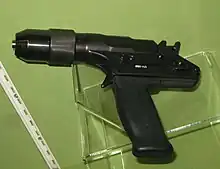Captive bolt pistol
A captive bolt pistol (also known as a captive bolt gun, a cattle gun, a stunbolt gun, a bolt gun, a stun gun and a stunner) is a device used for stunning animals prior to slaughter.
.jpg.webp)

The goal of captive bolt stunning is to inflict a forceful strike on the forehead with the bolt in order to induce unconsciousness. For the non-penetrating bolt gun variation, the bolt may or may not destroy part of the brain, while brain tissue is always destroyed with the penetrating bolt gun.
The bolt consists of a heavy rod made of corrosion-resistant alloys, such as stainless steel. It is held in position inside the barrel of the stunner by means of rubber washers. The bolt is usually not visible in a stunner in good condition. The bolt is actuated by a trigger pull and is propelled forward by compressed air, a spring mechanism, or by the discharge of a blank round ignited by a firing pin. After striking a shallow but forceful blow on the forehead of the animal, spring tension causes the bolt to recoil back into the barrel.
The captive bolt pistol was invented in 1903 by Hugo Heiss, former director of a slaughterhouse in Straubing, Germany.[1]
Variations
Captive bolt pistols are of three types: penetrating, non-penetrating, and free bolt. The use of penetrating captive bolts has largely been discontinued in commercial situations in order to minimize the risk of transmission of disease.
In the penetrating type, the stunner uses a pointed bolt which is propelled by pressurized air, spring mechanism, or a blank cartridge. The bolt penetrates the skull of the animal, enters the cranium, and catastrophically damages the cerebrum and part of the cerebellum. Concussion causes destruction of vital centers of the brain and an increase in intracranial pressure, causing the animal to lose consciousness. This method is currently the most effective type of stunning, since it physically destroys brain matter (increasing the probability of a successful stun), while also leaving the brain stem intact and thus ensuring the heart continues to pump during the exsanguination.[2] One disadvantage of this method is that brain matter is allowed to enter the blood stream, possibly contaminating other tissue with bovine spongiform encephalopathy (BSE, colloquially known as mad cow disease).[3]

The action of a non-penetrating stunner is similar, but the bolt is blunt with a mushroom-shaped tip. The bolt strikes the forehead with great force and immediately retracts. The subsequent concussion is responsible for the unconsciousness of the animal. This type of stunner is less reliable at causing immediate unconsciousness than penetrating types; however, it has undergone a resurgence of popularity because of concerns about mad cow disease. In the European Union, this captive bolt design is required for slaughter of animals that will be used for pharmaceutical manufacture.[4]
The free bolt stunner is used for emergency, in-the-field euthanasia of large farm-animals that cannot be restrained. It differs from a true captive bolt gun in that the projectile is not retractable; it is similar in operation to a powder-actuated nail gun or conventional firearm. Capable of firing only when pressed firmly against a surface (typically the animal's forehead), the device fires a small projectile through the animal's skull. The veterinarian can then either leave the animal to die from the projectile wound or administer lethal drugs.
Use
With cattle, goats, sheep, rabbits, and horses,[5] failure to adequately stun using a penetrating stunner can largely be attributed to incorrect positioning.[2] Captive bolts allow for meat trimmings from the head to be salvaged. In some veal operations, a non-penetrating concussive stunner is used in order to preserve the brains for further processing.
Captive bolt stunners are safer to use in most red meat slaughter situations. There is no danger of ricochet or over-penetration as there is with regular firearms.
The cartridges typically use 2 to 3 grains (130 to 190 mg) of smokeless powder but can use up to 7 grains (450 mg) in the case of large animals such as bulls. The velocity of the bolt is usually 55 metres per second (180 ft/s) in the case of small animals and 75 metres per second (250 ft/s) in the case of large animals.
Use for homicide
There have been a number of cases where a captive bolt pistol has been used for homicide, including:
References
- Ryder, Richard D. (2000). Animal revolution : changing attitudes toward speciesism. Oxford: New York. ISBN 9781859733301.
- Schütt-Abraham, I; Knauer-Kraetzl, B; Wormuth, HJ (January 1992). "[Observations during captive bolt stunning of rabbits]". Berliner und Munchener tierarztliche Wochenschrift (in German). 105 (1). ISSN 0005-9366. PMID 1543476.
- Anil, M. H.; Helps, C. R.; McKinstry, J. L.; Brown, S. N.; Philips, A.; Harbour, D.; Love, S.; Williams, S.; Shand, A. (May 2001). "Jugular venous emboli of brain tissue induced in sheep by the use of captive bolt guns". Veterinary Record. 148 (20): 619–620. doi:10.1136/vr.148.20.619. ISSN 0042-4900. PMID 11394796.
- "Note for guidance on minimising the risk of transmitting animal spongiform encephalopathy agents via human and veterinary medicinal products" (PDF). Archived from the original (PDF) on 2009-11-14. Retrieved 2010-09-13.
- Beam, Christopher (2009-02-25). "They Shoot Horses, Don't They?". Slate.com. Retrieved 2010-09-13.
- Betz, Peter; et al. (1993). "Homicide with a Captive Bolt Pistol" (PDF). Raven Press. Retrieved 2012-10-27.
- "Bolt-gun murder 'not predictable'". BBC News. 8 November 2011. Retrieved 2017-12-22.